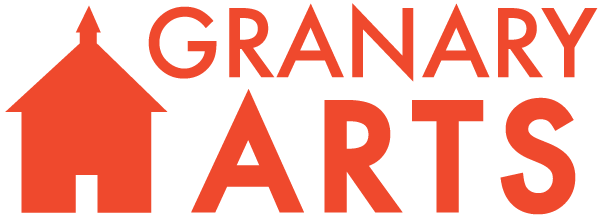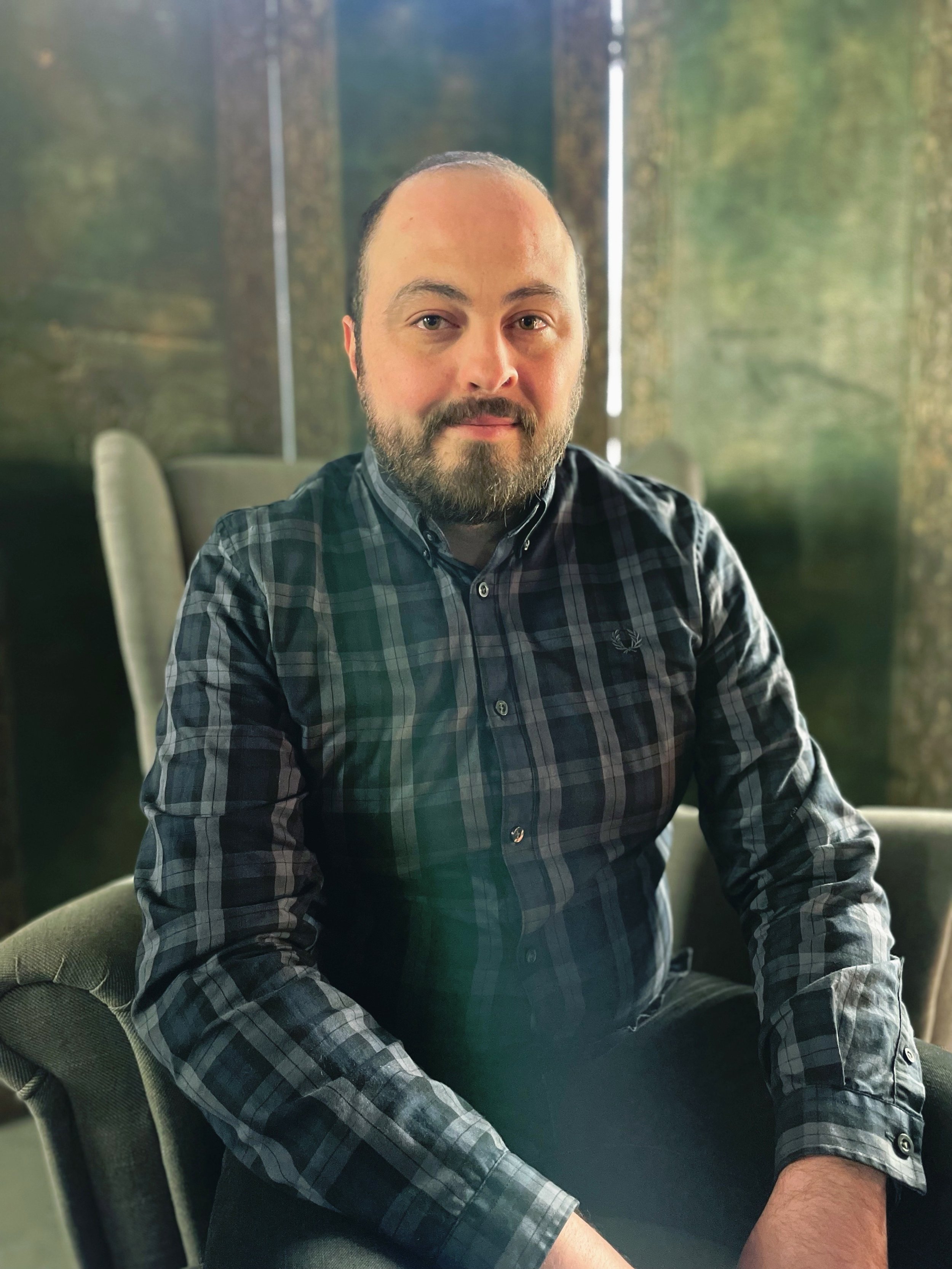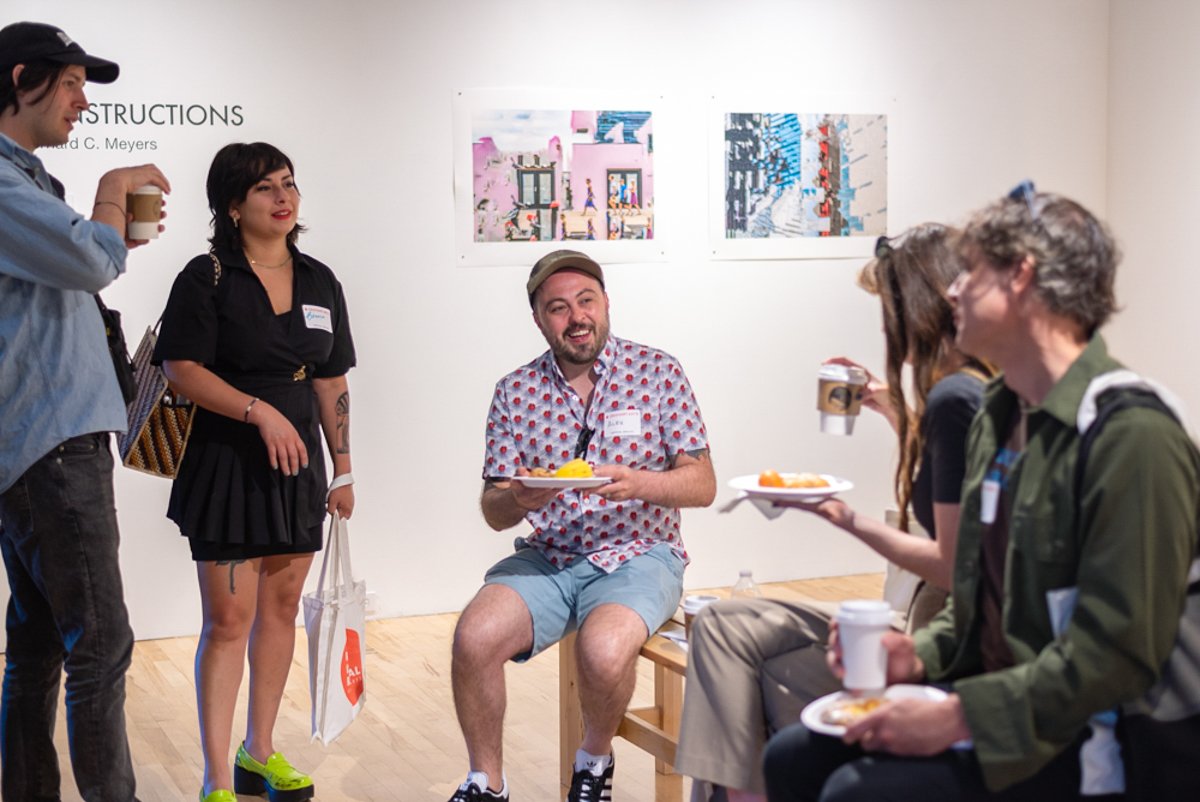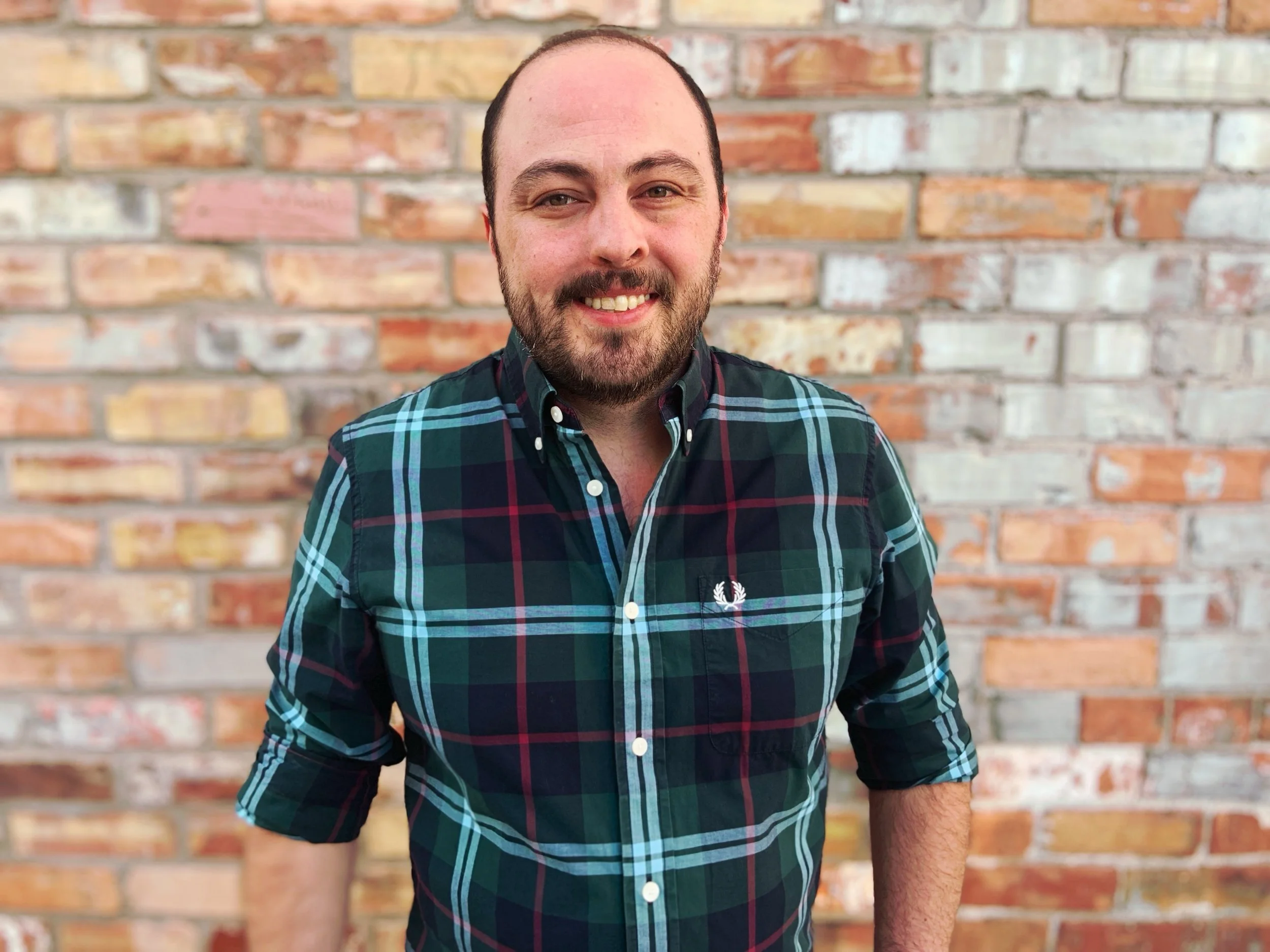ALEXANDER ORTEGA
2023
About the Fellow
Alexander Ortega is a Salt Lake City–based arts journalist and fiction writer, currently writing for Southwest Contemporary. He was a longtime editorial staff member of SLUG Magazine, where he was Editor and wrote about various arts practices. With a local focus, he investigates artworks’ rhetorical resonances, asking how artists forge new ideas and communicate them through visual media. Ortega’s fiction has been published in Quarterly West, Quarter After Eight, Moss literary journal, and an anthology called EVERGREEN: Grim Tales & Verses from the Gloomy Northwest. He was also a 2022 Summer Fishtrap Fellow.
Header image: Alexander Ortega
Small-City Synestheses: Embracing Different Art Disciplines in a Smaller Community
My experience as an art critic is gnarled and nontraditional, partly due to using synesthesia as an element of my writing practice. I came up writing about underground music—mostly punk, at first—through a Salt Lake City publication called SLUG Magazine. Nonetheless, I’ve crescendoed my role into what may be considered more straightforward art criticism, now covering contemporary art for Southwest Contemporary. Along with my colleague Bianca Velasquez, I was a selected art critic Fellow for CRITICAL GROUND 2023, where we spoke about our experiences of art criticism in smaller, noncoastal communities.
I shared some of how I deploy synesthesia at CRITICAL GROUND. It started as a tool to subvert my nontraditional background. I first utilized this perceptual phenomenon as a kind of fledgling-writer survival mechanism—relating disciplines like modern dance to music, for example, in order to articulate my impressions. I continue to find that it suits covering my local arts community, however. Overall, I think synesthetic thinking can elevate arts coverage of a smaller community with an eye toward entangling its creative identity.
In case it’s unfamiliar, the American Psychological Association refers to synesthesia as “a neurological condition that causes senses to link and merge.”[1] We may taste sounds, hear scents, or feel shapes. My most immediate synesthetic experience is common, to associate letters and numbers with colors. But I’m ever identifying new confluences of my senses, such as the colors of days of the week. The rabbit hole of synesthesia burrows deep, and individuals’ own personal experiences will vary. What I think matters regarding art criticism, though, is the human capacity to blend the senses, even just conceptually.
To a certain extent, all art critics employ synesthesia. When a music writer, for instance, describes the texture or color of music, they defamiliarize sound with tactile and visual imagery in order to isolate components of a work, underscore their effectiveness, and use them as evidence in a critique. The same goes for Museum of Contemporary Art Chicago’s artist statement about Rebecca Morris’s abstract painting oeuvre with respect to “gesture.”[2] Morris’s hyper–zoomed-in microcosms, of course, don’t actually move on the canvas but instead suggest snapshots of a journey through fizzy plasma (Untitled (#09–05)), the suspended moment before crinkly puzzle pieces come together (Untitled (#10–20)), or a point of anticipation before gurgling, molecule-like bodies converge toward osmosis (Untitled (#02–05)). In these ways, Morris invokes gesture in static objects.
Pulled out from conventional synesthetic language, I continue to find my footing in relating what I observe in visual art to other disciplines. The way I think of this, however, relates to more ineffable qualities of works in the kinds of material I’m drawn to. At CRITICAL GROUND, I expressed this outlook with the metaphor of a house, made of elements of art I’m drawn to—I’ll call it a “conceptual art house.” My examples at the think tank were somewhat different, but my localized examples here include a house built by set designer David Brothers in his absurd world of Rolithica, surrealist-style paintings on the wall by Wren Ross, the post–chamber music of Hoofless playing in the salon, and Michael Mejia’s speculative novel Tokyo on a sideboard.
These disparate artworks find themselves in conversation with each other through their dreaminess, strangeness, and dreariness—among many other characteristics. In my mind, these pieces gravitate toward and feather with each other, forming a heuristic of SLC art-making through their shared moods. While they of course don’t encompass the ever-in-flux diversity of SLC art at large, they capture a Venn diagram of local audiences and tastes linked through such moods yet formed by different disciplinary appeals to the senses.
An obstacle I believe synesthesia can help overcome is smaller art communities’ having fewer people. A core issue that CRITICAL GROUND addresses is the lack of national arts coverage from places such as Salt Lake City and Utah. And past our lack of attention, SLC is much smaller than other noncoastal American cities such as, say, Chicago. Though we’re home to worthy artists and work, we don’t have the same kind of critical mass. While we’re definitely growing, bouncing back from losses of venues or seminal artists moving away feels strenuous. We often falter in our momentum if a key gallery like Nox Contemporary closes, finding ourselves waiting for someone to fill a niche for contemporary art spaces.
I’m an outsider to proverbial “big cities,” on the coasts or otherwise. But my impression is that they possess more regenerative capabilities: with more people, I assume that a commensurate number of contemporary art spaces, communities, and forums would hold down the fort if a major pillar would go under while other actors filled the void of what disappeared. While I’m sure it’s immeasurably more fraught than my facile assumption, my home of SLC chugs more like the little city who could—we make do, but our losses feel like they rattle the very existence of our sheerly smaller arts community.
These moments of crisis show that, presently, a place like SLC is fundamentally different from more populous cities and regions—or at least my hypothesis about them. Hence, even when we’re not in crisis, the ways in which we navigate and consider our art community require scrappy efficiency that builds on our broader retinue of creators. And for me, it’s not enough just to like the work of different art media and disciplines. Instead, I feel like traversing different local scenes—whether it be contemporary art, music, literature, etc.—can help foster a robust arts culture by way of interlinked, community-savvy patronage.
In this regard, I feel an affinity for the stylistic unity of historical western art movements. Not the history of imperialism and colonialism that may come along with them, of course, but the spirit in which artists of different disciplines participated in whatever moment had emerged. In tandem with painters, it makes sense to refer to Baroque architects, Romantic composers, or Modernist writers. The conceptual framework of what might constitute art of any of those movements—e.g., the wistful scenes and sounds of Romantic painting, poetry, and orchestra—poses a way to locate ourselves at a certain point in history.
I don’t think that the arts culture of SLC needs any prescriptive “moment” or movement for artists to follow whatsoever. But I wonder if one way the SLC community may consciously engage with local artwork might be to internalize the mechanisms of such movement-oriented thinking. That is, to engage with disparate disciplines with individualized synesthetic mindsets. I believe the seedlings of this idea already exist here. SLC musician and ballet dancer Nora Price, for instance, blends her worlds of rock music and dance. In my eyes and likely many others’, her dual disciplines inform each other, rather than privileging just one. As a result, I’ve seen engagement in her practice from both dance- and music-oriented community members. I believe that this kind of dually reinforced engagement leverages the innate synergy—in other words, scrappy efficiency—of smaller communities such as SLC.
Disciplinary confluences rooted in community also seem to bring more people and momentum to shows. Take Mestizo Institute of Culture and Arts (for whose board I’m being courted at the time of writing, for transparency). Their 2023 reopening saw a robust turnout as the celebration hosted Latine- and BIPOC-focused visual art, craft wares, and an adaption of From the Borderlands to the Roots by dancer Stephanie García. In a speech commemorating the nonprofit’s new chapter, former MICA founder, SLC expat, and painter Ruby Chacón commented on the number of new faces of those present at the robustly attended opening. As far as this kind of turnout, I see the success of the opening owing in some part to the show’s creative admixture. Her comments align with Salt Lake City’s gradual population growth[3] but also show that, despite SLC’s still relatively small population, mixing disciplines can marble a community together in unique ways.
Past the occasion of opening celebrations, I wonder about how SLC’s art communities may carry this appetite into the diffuse disciplines and scenes we’re home to. On a purely anecdotal level, I often find that my discussions with those in the visual arts world about local music or those in dance about visual art fall flat. To me, interactions like these feel like a lack awareness of what else SLC has to offer outside of someone’s arts silo. Additionally, because having multidisciplinary shows just for the sake of having them may not gel or be appropriate for many occasions, it feels like an onus of localized arts exploration falls to us as patrons, art-lovers.
Those in bigger cities can afford to engage with their chosen art forms due to their large numbers to support any given discipline’s scene. While none of us in SLC can do it all, balkanizing our local-art experiences may well shoot us in the foot if we want to forge a regional arts identity for ourselves in terms of sustaining our levels of activity. I feel that a consistent yet ever-growing sense of identity arises from the valences we affirm when we support those working in diverse disciplines. A distinct sense of who we are as an arts community could very well arise from how our artists and their work are in continual conversation with each other.
During my time with SLUG, my continual engagement with a smorgasbord of local artists poised me to contend not only with creating content but also with why a poet like Abraham Smith of Ogden, Utah, and an SLC painter like Andrew Alba struck similar chords within me, underscoring why Utah art is special. With those two—for me—it’s their shared penchant for confronting the rawness of character. And while either of them could just as well move away, they’ve both left and continue to leave an indelible impression here.
In following both of them, revisiting either of their bodies of work feels like I satisfy a need for the quality of “raw character.” Yet I overindulge as I revisit the other, subverting the relatively smaller amount of art in SLC/Utah by appropriating artworks within a pool of synesthetic relationship. All the while, I’ve veritably cloned myself across local disciplinary conversations—superimposing another audience member somewhere I may not have been otherwise. I see my trail-making between these two or additional artists as an act of pronouncing the sinews withinin the larger body of Utah art. I feel that if more local people traced such cross-disciplinary veins of their tastes, the resultant sense in which we’d feel the ongoing vibrance of our creative community would feel perennial, breathing, vital as they, too, “cloned” themselves. We’d always have something to see or hear or behold.
My role as a critic, generally speaking, is to convince those reading my words to locate themselves within how artworks and artists make meaning. In the spirit of CRITICAL GROUND as a forum for inquiry, my message is a string of questions: what local artworks do you construct your conceptual art house with? Which filmmaker conjures your walls? Whose paintings hang from them? Whose music animates your steps? Who dances in your halls, and whose voice speaks to you from the book on your nightstand? In what way are you both a curator and critic who distinguishes your house by way of your local selections? How do your senses blend these works to form a distinct taste of home for you?
With this synesthetic approach to being a patron, I see SLC art lovers gnarling tastes together and supporting artists to a point where our viability as an arts community is undeniable. We don’t need traditional disciplinary divisions to nurture our local-art sensibilities. We need angry modern dance and agitated music to paint our walls neon. Absurdist prose poetry and cartoonish sculpture should reveal new hallways and nooks within our home inside us. May your balustrades creak out a local actor’s lines, because no one will make your house weird and worthy if you don’t build a strange one.
[1] “Tasty Words, Colorful Sounds: How People with Synesthesia Experience the World, with Julia Simner.” American Psychological Association. Accessed November 27, 2023. https://www.apa.org/news/podcasts/speaking-of-psychology/synesthesia.
[2] “Rebecca Morris: 2001–2022.” MCA Chicago, October 3, 2023. https://visit.mcachicago.org/exhibitions/rebecca-morris-2001-2022/.
[3] United States Census Bureau. “Salt Lake City City, Utah - U.S. Census Bureau QuickFacts.” n.d. Accessed November 29, 2023. https://www.census.gov/quickfacts/fact/table/saltlakecitycityutah/PST045222.




